When To Change Your Google Ads Bid Strategy
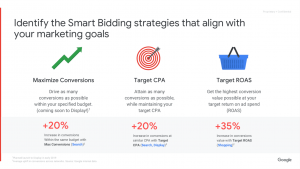
It seems like new, automated AI bid strategies are being released by Google so often that it’s hard to keep up. Back in the day there were only a few bid strategies and for the most part, people set their bids manually.
Now with all these new automated bid strategies, it can be difficult to know what each is for, and more importantly, when to use which.
Below we’ll be outlining the automated bid strategies that you need to know about and more importantly, when the right times are to use them.
Bid strategies to know
So a bid – for those of you that don’t know – is how much an advertiser is willing to pay for a click on their ad when a keyword they’re going after is searched on Google.
Since Google charges advertisers on a per click basis, the traditional strategy for bidding consisted of manually setting a bid price for each keyword.
Overtime as Google’s systems got smarter with more data and AI technology, the platform, and as a result people, started moving away from this “archaic” bid strategy and more towards “goal-based” automated bid strategies.
These automated strategies use AI, historical data, and user data across Google’s platforms (Google, YouTube, Gmail, websites with AdSense, so on and so forth…) to target ads towards users who are most likely to match a certain goal that advertisers on Google may have.
These goal-based automated bid strategies are set at the campaign level and share the name of the function they serve. They are as follows: maximize clicks, maximize conversions, target CPA, target ROAS, and target impression share.
Maximize Clicks
The maximize clicks bid strategy does exactly what you think. It bids on keywords with the sole purpose of maximizing the amount of clicks on ads that lead users to a website or landing page of the advertiser’s choosing.
Maximize Conversions
The maximize conversions bid strategy focuses keyword bids on those that are most likely to lead to a conversion. A conversion is in essence a valuable action that an advertiser wants users to take outside of just going to the website or landing page.
Conversions can be anything from a phone call or form submission for service based businesses, or a purchase or newsletter subscription for ecommerce businesses.
It’s really up to the advertiser’s choosing whether or not they find a specific action valuable enough to track as a conversion.
Target CPA
CPA stands for cost per acquisition. With this bid strategy, Google focuses on bidding for keywords that will get conversions or acquisitions (phone calls, leads, purchases, subscriptions, etc.) – defined by the advertiser – at or around a certain cost every time.
You will have to define what that target cost is in Google Ads when choosing the target CPA bid strategy and the number you choose has to be somewhere in the ballpark of what you already see conversions coming in at (more on this later).
Target ROAS
Similar to target CPA, the target ROAS bid strategy also works by providing a value to Google, but instead focuses on reaching a desired return on ad spend versus an acquisition.
Here, the value you provide is not a dollar amount (like in target CPA), rather a percentage which tells Google how many times your ad spend you want to get back in purchases. Again, just like target CPA, the value you provide has to be realistic and based around some historical data.
This bid strategy is only available to businesses that sell something online – like ecommerce stores – and have a value, or dollar amount attached to their conversions.
Target Impression Share
The target impression share bid strategy is mainly used for businesses that want to increase brand awareness on search engines rather than placing a focus on a particular action for users to take.
Based on the value that you provide, Google prioritizes showing your ads a certain percentage of the time for the keywords you’ve chosen.
For example, if your business is Green Beach Bicycles and you want to make sure your ad shows up 90% of the time when people search your business, then you’d pick the target impression share bid strategy with the value of 90%.
When to use Maximize Clicks
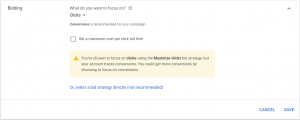
So now that you know what the maximize clicks strategy entails, when is the right time to use it?
Most businesses utilize online advertising to bring in conversions rather than to simply get website traffic or increase brand awareness. Since this bid strategy focuses on getting the largest number of people to click on your ads and get to your landing page, it’s not a long term bid strategy you want to follow, but it is one you want to start with.
Regardless of if you want to drive conversions, you should choose the maximize clicks bid strategy when starting a new Google Ads campaign.
With new campaigns, Google doesn’t really know which people are going to convert. Max clicks allows the system to bring in as much website traffic as possible from all types of different customer profiles.
If you have conversions set up, even on max clicks, Google will keep track of what types of users are converting in the background to be used later for other bid strategies.
Conversion based bid strategies rely on historical data. With new campaigns, there is very little historical data and Google doesn’t need quite as much information to drive clicks to your site as it does to drive conversions.
That’s why usually when building out new campaigns, you want to start with the maximize clicks bid strategy so Google’s algorithm can learn as quickly as possible while still recording some conversions.
Keep in mind that if you’re focused on getting conversions, max clicks is a strategy you want to employ only at the start of a fresh campaign and that it’s not a long-term solution to an effective Google ads campaign.
Around the month 2 mark, and after the campaigns have produced anywhere from 5 to 10 conversions, we look at changing to a more conversion focused bid strategy.
When to use Maximize Conversions
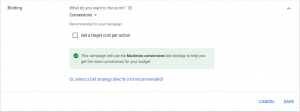
Maximize conversions is probably the most simple conversion based bid strategy as it simply tells Google to find you the most possible conversions with your daily budget as possible.
Keep in mind that this bid strategy will likely spend your entire daily budget every day regardless of if it’s likely to bring you conversions or not.
The right time to use max conversions is when a specific Google campaign has had enough historical data – typically 5 to 10 conversions – to be able to optimize towards the conversions you’ve set.
Typically around the 2nd month mark of a campaign is when the data is sufficient enough to switch from a manual bid strategy or a “starter” bid strategy like max clicks to max conversions.
Each time you switch your bid strategy, your campaign will go back into learning mode. Don’t let this scare you away if you see a slowdown in conversions when you switch to max conversions (especially from max clicks).
Maximize conversion value

There is also a subset bid strategy of maximize conversions called maximize conversion value. This strategy employs Google’s algorithm to not just drive the most conversions, but drive the most conversions with the highest value.
To use this strategy you have to have a dollar value associated with the conversions you want to optimize. For example, an ecommerce store that tracks conversions as purchases.
Just like max conversions, you should change to this bid strategy after 5-10 value-based conversions have been recorded, typically after the first month of running a campaign.
When to use Target CPA

The more complicated the conversion-based bid strategy gets, the more historical data is going to be needed before being able to effectively switch over. This is definitely the case with the target CPA bid strategy.
Target CPA utilizes tons of historical data on conversions, particularly the average cost that each conversion has come in at over a several month period. That’s why Google doesn’t usually recommend target CPA until a campaign has successfully been producing conversions for 3 or more months.
Even with this, we recommend anywhere from 20 to 30 conversions in the past 30 days – which can take months of learning to reach – before moving over to target CPA.
Even once this threshold has been reached, you should only use target CPA if you’re looking to meet certain return on investment goals. This bid strategy may produce less conversions than max conversions, it only ensures that you’re getting these conversions at better costs.
If target CPA sounds right for you, look at switching over to this bid strategy after you’ve had a good month of conversions (20 or more) and plan on conversion volume slowing down for at least the first 2 weeks while the campaign goes back into learning mode.
While switching over to target CPA, you’ll see that Google has a recommended dollar amount to set your target at. You can either follow Google’s recommendation or set your target a couple dollars higher than your cost per conversion in the past 30 days.
When to use Target ROAS
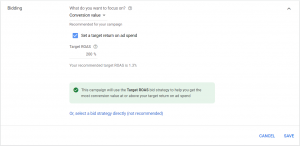
Target ROAS is another advanced conversion bid strategy that requires lots of historical data to effectively function and provide value to advertisers.
With this bid strategy, Google’s algorithm tries to drive the highest return at the lowest cost to maximize your return on ad spend. To do this it looks at months of data on conversions that have values tied to them and adjusts accordingly.
Similar to how you can transition max conversions to target CPA after several months of data, the same is recommended with max conversion value to target ROAS.
You want to have at least 20 purchases or conversions with values tied to them in the past 30 days before moving your bid strategy to target ROAS.
Just like target CPA, Google may recommend a target ROAS for you to start with. You can either go with this or calculate your past 30 days ROAS and err on the side of caution by choosing a percent return that is a bit lower than what you’ve been seeing.
To calculate your ROAS, take the total conversion value produced from ads in the past 30 days and divide by the total spent on ads in the past 30 days. Then take that number and multiply by 100 to convert it to a percentage.
When to use Target Impression Share
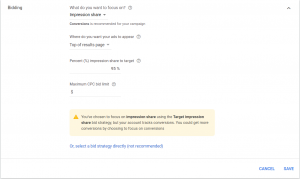
Switching to the target impression share bid strategy isn’t a time-based or number of conversions based process like the ones listed above.
Target impression share is a brand awareness play and should be used mainly for brand campaigns or specific keywords that you want to make sure you show up for every time, regardless of the outcome.
You can deploy this bid strategy at the start of any campaign if you’re sure your goal is to show up as often as possible.
When choosing target impression share, you’ll be given the ability to choose the percentage of the time you want to show up for the keywords you’re going after, as well as where on the page you want to show. The options are “anywhere on the page”, “top of page”, and “absolute top of page”.
Parting thoughts
Overall you want to avoid choosing the “sexiest” bid strategy just because it’s the most advanced and takes a lot more factors into account. Choose a bid strategy that actually makes sense for your business and your goals.
For a lot of businesses, maximize conversions is the right way to go and produces the most results. If something is working and you don’t absolutely need to change it, then don’t.
When you employ a new bid strategy, your campaigns will go back into learning mode and your results may dip for a couple weeks. If you’re not prepared for this or don’t want to risk the success you’re already seeing, then think about maybe starting a fresh campaign with the goal of eventually moving it into some of the more advanced bid strategies.
At the end of the day, your bid strategy should be a 1:1 reflection of your advertising goals. Want to get the most leads or purchases? Max conversions. Really want to hone in on your ROI? Target CPA or target ROAS. Want to increase brand awareness and traffic to your website? Max clicks or target impression share.
Let us know what your thoughts are or if you have any questions below!